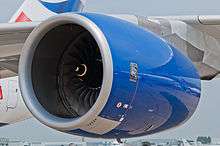Wide chord
A wide chord fan engine is a term to describe a modern turbofan jet engine having a ducted fan with a specific blade geometry - In layman's terms, they would be described as having wider blades than other jet engines. The technology was pioneered by Geoff Wilde at Rolls-Royce in the 1970s [1] and development from a variety of manufacturers continues today.

Overview
The main fan on a jet engine consists of a number of aerofoils mounted at the rotational center on the fan disk, and as the engine core rotates the fan blades accelerate an air mass and create the force to move forward which gives thrust (in accordance with Newton's Third Law).
In theory the larger the fan diameter (the line from the tip of one fanblade to its opposite member) the greater the thrust. In practical applications, fan size is limited by the weight, the space available around the aircraft and by the increased drag (resistance) generated by the larger frontal area.
In the race to achieve better fuel economy, more thrust and less weight & noise from jet engines, designers have refined the blade design and materials to extract more thrust for any given fan disk area. One significant improvement[2] is to make blade chords wider and, more recently, alter the blade geometry to give it a scimitar-like shape. Further refinements include making the blades from a light material such as titanium and to manufacture them with a hollow cross-section.
Modern jet engines such as the Rolls Royce Trent 900 and the Engine Alliance GP7000, which both power the Airbus A380, are examples of wide-chord fan engines.
Key design considerations
The geometry of a jet engine blade is essentially that of an airfoil and as such, there is no single optimum design. As with most mechanical components, the blade is a compromise in trying to achieve as large a blade area as possible within the practical constraints: Widening the blade chord will increase the blade drag while lengthening the blade will increase tip speed (and noise) plus it may make the fandisc impractically large. A larger blade is also heavier, which when taken together with increasing tip speed as the fandisc gets larger, puts a point of diminishing return between weight and blade length (tip speed.)[3]
A wide chord engine addresses this by having fewer, wider, blades meaning a wide chord fan engine will have fewer, but more effective, fanblades compared to a regular jet engine. To address the weight issue, blades are often hollow and made from titanium. Finally, blades are often given a scimitar shape to achieve higher flying speeds. The Wide-Chord Swept fan blade was designed and developed at Rolls-Royce Barnoldswick in Lancashire, and is still manufactured there to this day. The process uses Superplastically formed, diffusion bonded technology to achieve the light weight, strong design. [4]
References
- http://civil.rolls-royce.com/wide-chord-jet-engine-fan-blades/
- http://civil.rolls-royce.com/wide-chord-jet-engine-fan-blades Rolls Royce Plc, 2004
- http://www.aerospaceweb.org/question/propulsion/q0039.shtml Aerospaceweb.org; Jeff Scott, 12 August 2001
- http://www.geae.com/education/vocabulary.html | GE Aviation: Engine Education, 2008